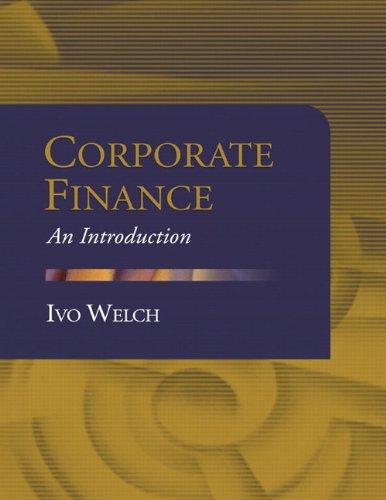The solution proceeds the same way as in the text on page 396 (Chapter 12): (a) The
Question:
The solution proceeds the same way as in the text on page 396 (Chapter 12):
(a) The project should have an appropriate rate of return of E(˜r) = 3% + 4% . 0.5 = 5%. It is immediately obvious that the project’s cost of capital of 5% is below its internal rate of return of $11/$10 − 1 = 10%.
The net present value of the project is −$10 + $11/1.05 ≈ $0.48 million. Yes, the firm should take it.
(b) If the firm uses a cost of capital based on its beta of 3, it would conclude that the value is E(˜r) =
3% + 4% . 3 = 15%. Thus, with its 10% expected rate of return as its internal hurdle rate, a misguided firm would not take this project. This means that the firm loses $0.48 million in value it could have otherwise gained, simply because the firm managers are making the mistake of not taking the positive-
NPV project. This is because they do not understand that projects should be evaluated by the projects’
own costs of capital, not the firm’s cost of capital.
(c) The value of the new project today is $11/1.05 ≈ $10.48 million. The value of the old projects was given as $100 million. Thus, the value of a combined firm with all projects would be about $110.48 million.
(d) To raise $10 million, the firm needs to give up $10/$110.48 ≈ 9.05% of the combined firm to new shareholders.
(e) $10.48 million would be from the new project. $100 million would be from the old project. Thus,
$10.48/110.48 ≈ 9.49% of the firm value would be in the new project. The remaining 90.51% would be in the old projects.
(f) The market beta of the combined firm would be 90.51% . 3 + 9.49% . 0.5 ≈ 2.763.
(g) The average cost of capital would now be 3% + 4% . 2.763 ≈ 14.05%.
In sum, the value of the firm would jump by the net present value of the new project, that is, by $0.48 million. No more calculations are necessary. However, you can also do this by computing the discount on the entire firm. First, to be worth $100 million at a cost of capital of 15%, the expected payoffs next year have to be $115 million. The future value of the combined firm is therefore $115 + $11 = $126 million, and its present value is ($115 + $11)/(1 + 14.05%) ≈ $110.48 million.
Step by Step Answer:







